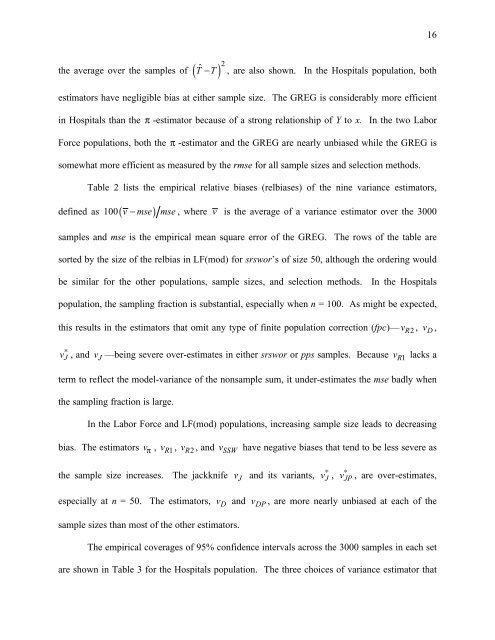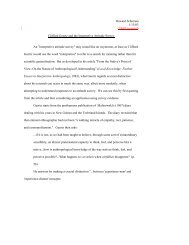Variance Estimation for the General Regression Estimator
Variance Estimation for the General Regression Estimator
Variance Estimation for the General Regression Estimator
Create successful ePaper yourself
Turn your PDF publications into a flip-book with our unique Google optimized e-Paper software.
16<br />
<strong>the</strong> average over <strong>the</strong> samples of (<br />
ˆ<br />
) 2<br />
T − T<br />
, are also shown. In <strong>the</strong> Hospitals population, both<br />
estimators have negligible bias at ei<strong>the</strong>r sample size. The GREG is considerably more efficient<br />
in Hospitals than <strong>the</strong> π -estimator because of a strong relationship of Y to x. In <strong>the</strong> two Labor<br />
Force populations, both <strong>the</strong> π -estimator and <strong>the</strong> GREG are nearly unbiased while <strong>the</strong> GREG is<br />
somewhat more efficient as measured by <strong>the</strong> rmse <strong>for</strong> all sample sizes and selection methods.<br />
Table 2 lists <strong>the</strong> empirical relative biases (relbiases) of <strong>the</strong> nine variance estimators,<br />
defined as 100( v − mse)<br />
mse, where v is <strong>the</strong> average of a variance estimator over <strong>the</strong> 3000<br />
samples and mse is <strong>the</strong> empirical mean square error of <strong>the</strong> GREG. The rows of <strong>the</strong> table are<br />
sorted by <strong>the</strong> size of <strong>the</strong> relbias in LF(mod) <strong>for</strong> srswor’s of size 50, although <strong>the</strong> ordering would<br />
be similar <strong>for</strong> <strong>the</strong> o<strong>the</strong>r populations, sample sizes, and selection methods. In <strong>the</strong> Hospitals<br />
population, <strong>the</strong> sampling fraction is substantial, especially when n = 100. As might be expected,<br />
this results in <strong>the</strong> estimators that omit any type of finite population correction (fpc)— v R2<br />
, v D ,<br />
vJ<br />
∗ , and v J —being severe over-estimates in ei<strong>the</strong>r srswor or pps samples. Because v R1<br />
lacks a<br />
term to reflect <strong>the</strong> model-variance of <strong>the</strong> nonsample sum, it under-estimates <strong>the</strong> mse badly when<br />
<strong>the</strong> sampling fraction is large.<br />
In <strong>the</strong> Labor Force and LF(mod) populations, increasing sample size leads to decreasing<br />
bias. The estimators v π , R1<br />
v , v R2<br />
, and v SSW have negative biases that tend to be less severe as<br />
<strong>the</strong> sample size increases. The jackknife v J and its variants, v ∗ J , v ∗<br />
JP , are over-estimates,<br />
especially at n = 50. The estimators, v D and v DP , are more nearly unbiased at each of <strong>the</strong><br />
sample sizes than most of <strong>the</strong> o<strong>the</strong>r estimators.<br />
The empirical coverages of 95% confidence intervals across <strong>the</strong> 3000 samples in each set<br />
are shown in Table 3 <strong>for</strong> <strong>the</strong> Hospitals population. The three choices of variance estimator that
















